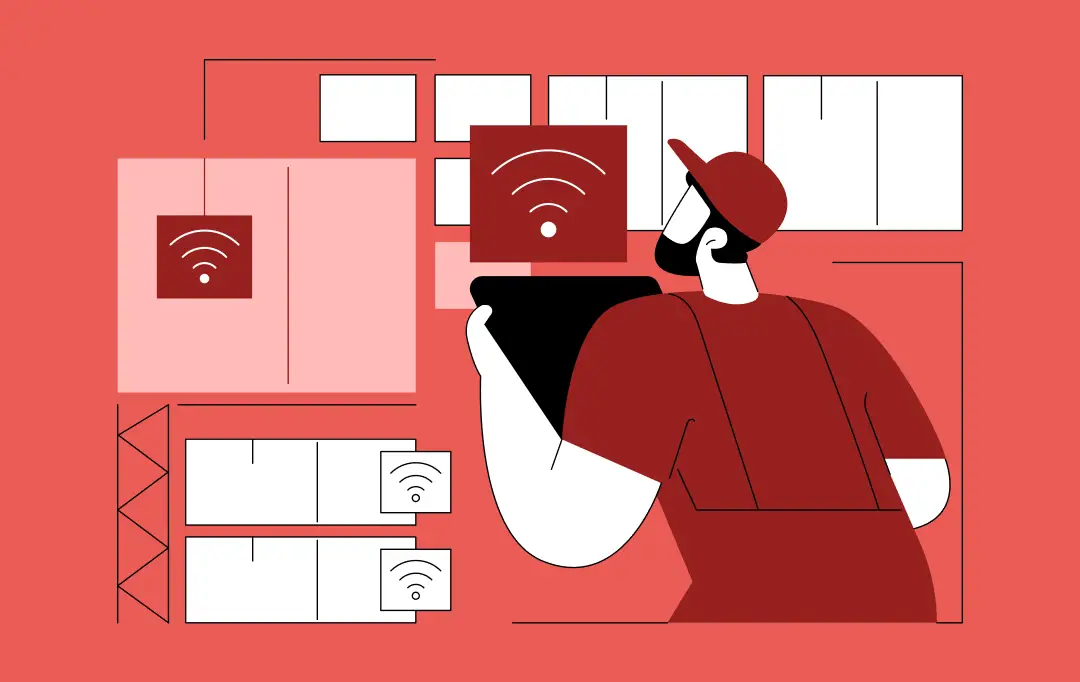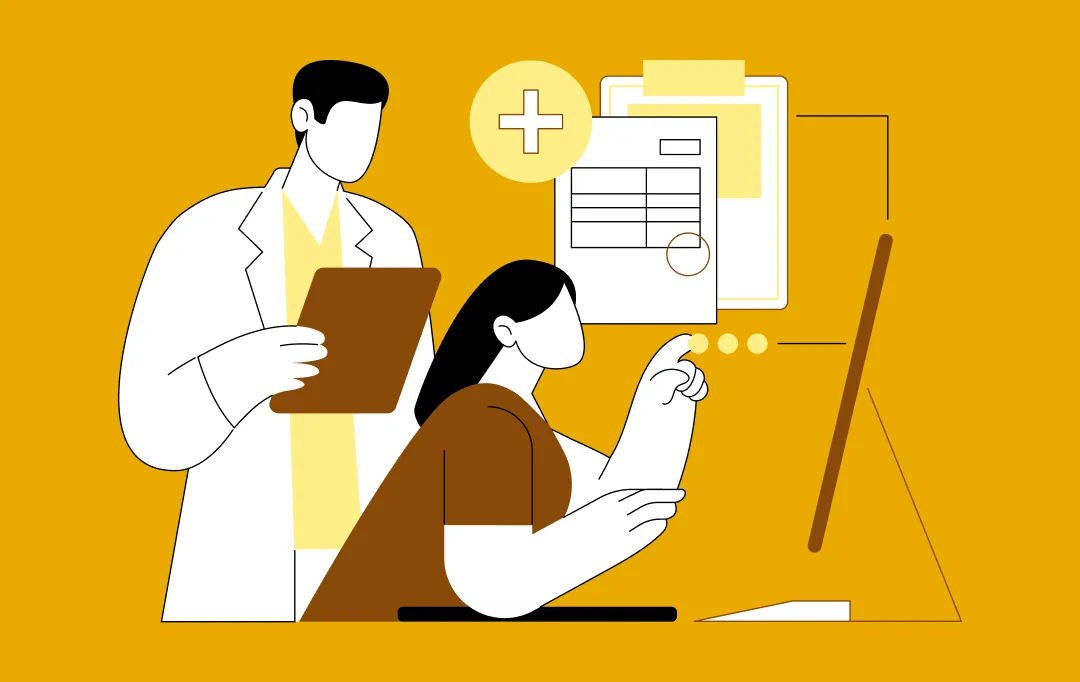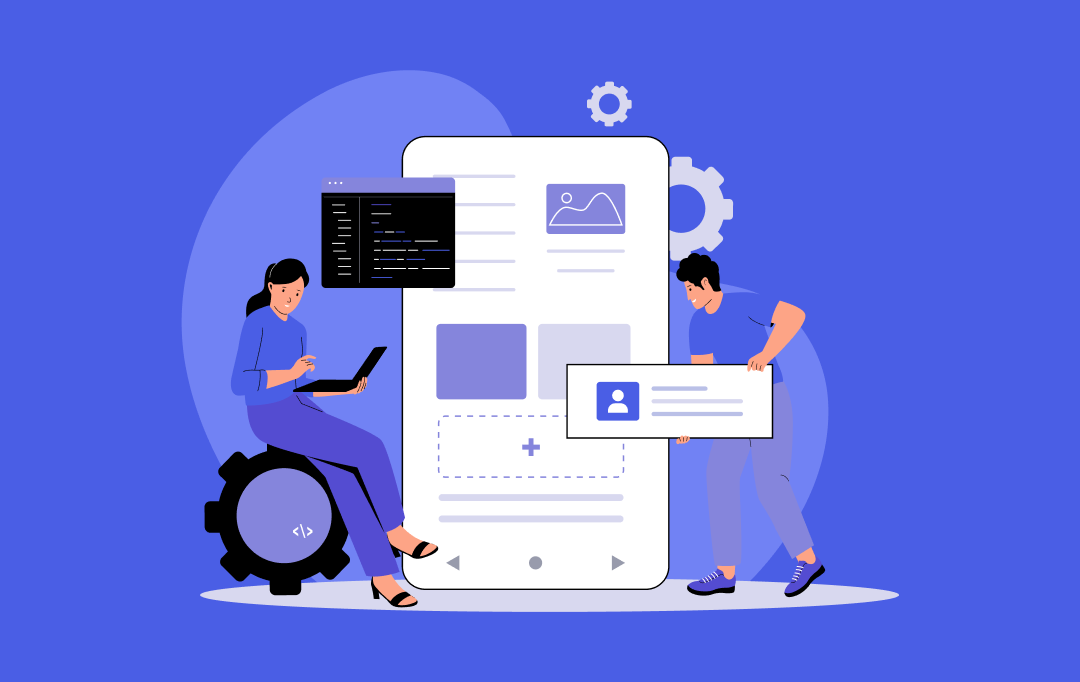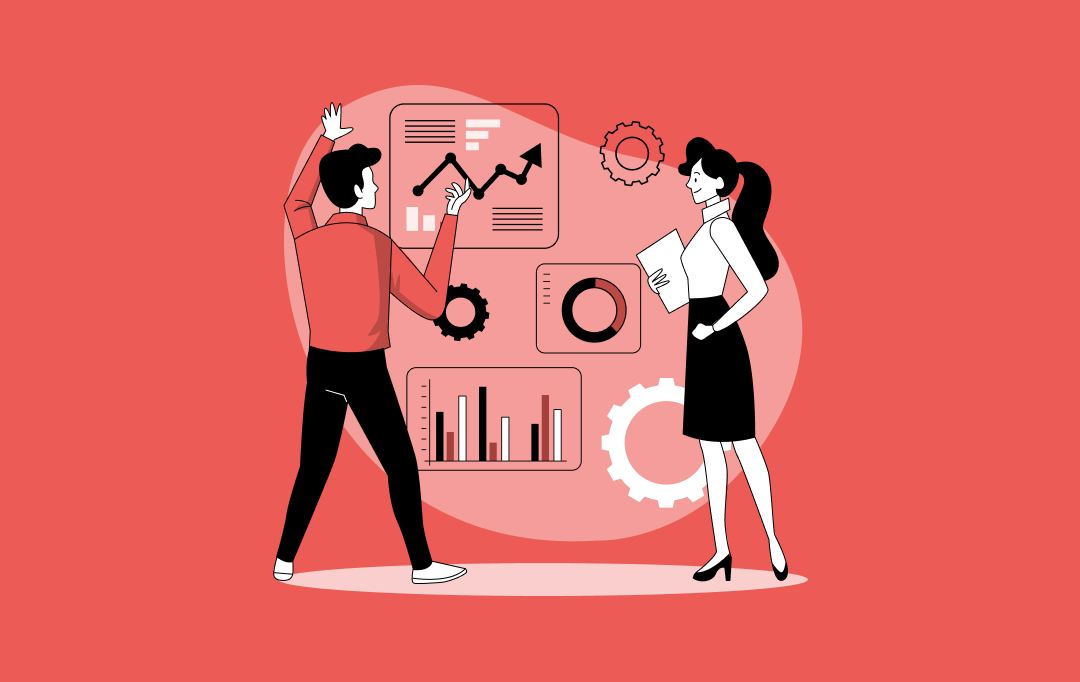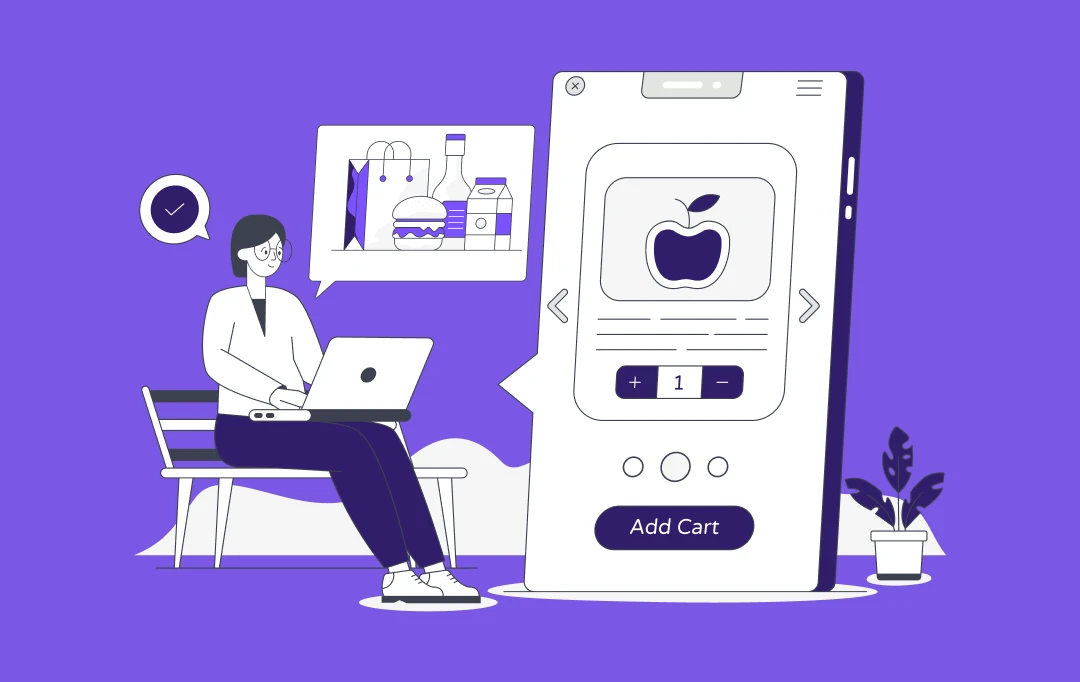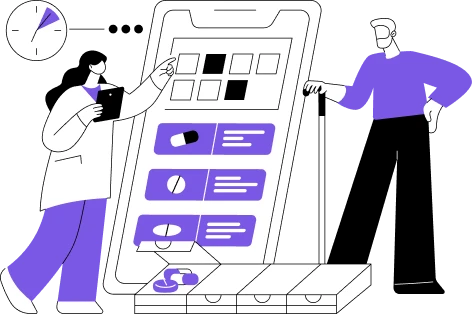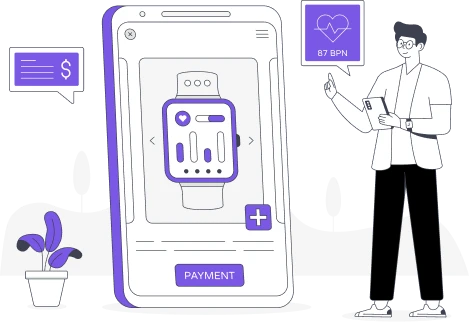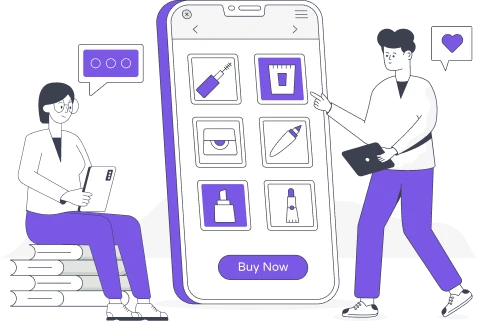- Traditional Diet Apps vs AI-Powered Planners
- How Much Does It Cost to Build an AI-Powered Diet Planner App
- Estimated Cost Breakdown
- Cost by Development Stage
- Key Factors That Influence AI Diet App Development Cost
- 1. AI Model Scope and Complexity
- 2. Data Acquisition and Labeling
- 3. Inference Infrastructure and Scalability
- 4. MLOps and Continuous Retraining
- 5. Compliance and Security
- Core Features to Have in Your AI-Powered Diet Planner App
- AI Enabled Features
- Basic Must Have Features
- How AI Powered Diet PlanningApps Get Smarter Every Day
- Use Cases: How Real Brands Are Transforming Diet Planning with AI
- 1. Noom – When Logging Turns Into Coaching
- 2. MyFitnessPal – From Tracking to Planning
- 3. Lumen – Turning Breath Into Data
- 4. Fitbit – AI That Connects Diet, Sleep, and Movement
- ROI Story: Why Personalization Pays (and Why Investors Care)
- Pitfalls (and How to Avoid Them)
- 1. Over-Engineering AI Before You Validate Demand
- 2. Ignoring Model Retraining and Data Drift
- 3. Cloud Sticker Shock
- 4. The “Black Box” Problem
- Compliance & Trust Checklist
- 1. PII / PHI Handling — Protect What You Collect
- 2. User Agency — Give People Control
- 3. Explainability — Make AI Understandable
- 4. Governance — Build for Accountability
- Roadmap: A Phased Build to De-Risk Cost
- Phase 1: MVP (8–12 Weeks)
- Phase 2: V2 - Intelligence and Insight (12–20 Weeks)
- Phase 3: Scale From Product to Platform (Ongoing)
- Future Trends and Market Signals to Follow (2025 and Beyond)
- 1. Health Leaders Are All In on AI
- 2. From Pilots to Production: The Execution Era
- 3. The Personalization Gap Keeps Getting Wider
- 4. HealthTech’s Growth Curve Is Accelerating
- 5. What’s Next: The Next 3 Years of AI in Nutrition
- Why Partner with Appinventiv
- FAQs
Key takeaways:
- Start small, learn fast. You don’t need to build everything in one go. Get the basics right, see how people use it, and let real feedback shape what comes next.
- Data is your backbone. Fancy AI means nothing if the data’s messy. The cleaner your nutrition data, the smarter and more trustworthy your app feels.
- Privacy is personal. People share their eating habits and health stats with you — that’s personal stuff. Protecting it isn’t just law, it’s respect.
- Personalization keeps people coming back. When your app feels like it “gets” them and not just counts calories, users stick around longer and actually pay for the experience.
- Work with people who’ve done it before. The right team won’t just code, they’ll help you avoid the common traps in AI diet planner app development and get to market faster, without burning money on guesswork.
Most people are tired of generic diet plans that tell everyone to eat the same things and expect the same results. They want something that listens, an app that understands when they’ve skipped a workout, slept poorly, or changed routines and still guides them toward their goals. That’s what AI diet planner app development is solving today, replacing rigid templates with adaptive, learning-based nutrition coaching.
The timing couldn’t be better for AI diet app development. According to Fortune Business Insights, the global digital health market is projected to surge from $427.24 billion in 2025 to $1,500.69 billion by 2032, growing nearly 20% annually. At the same time, a McKinsey report showed 85% of healthcare leaders are already exploring or implementing generative-AI solutions to personalize care and improve decision-making.
For startups and enterprises exploring custom AI diet planner app development, this blog breaks down everything you need to know; from AI diet planner app development cost and architecture to compliance, personalization, and strategy. The rise of AI-powered diet apps marks a new chapter for digital wellness, where machine learning turns user data into adaptive insights.
Build your scalable AI diet planner app with Appinventiv.
Traditional Diet Apps vs AI-Powered Planners
Traditional diet apps are built to record. AI-powered diet planning apps are built to respond. While older systems rely on user input and static rules, an AI-powered diet planner app continuously studies patterns, habits, and goals to deliver what feels like one-on-one guidance.
When you invest in AI diet app development, you move beyond tracking to prediction. The app begins to think like a coach, adjusting recommendations based on how a person eats, moves, and recovers. The features of AI diet planner app redefine user experience, offering more personalization that drives higher retention.
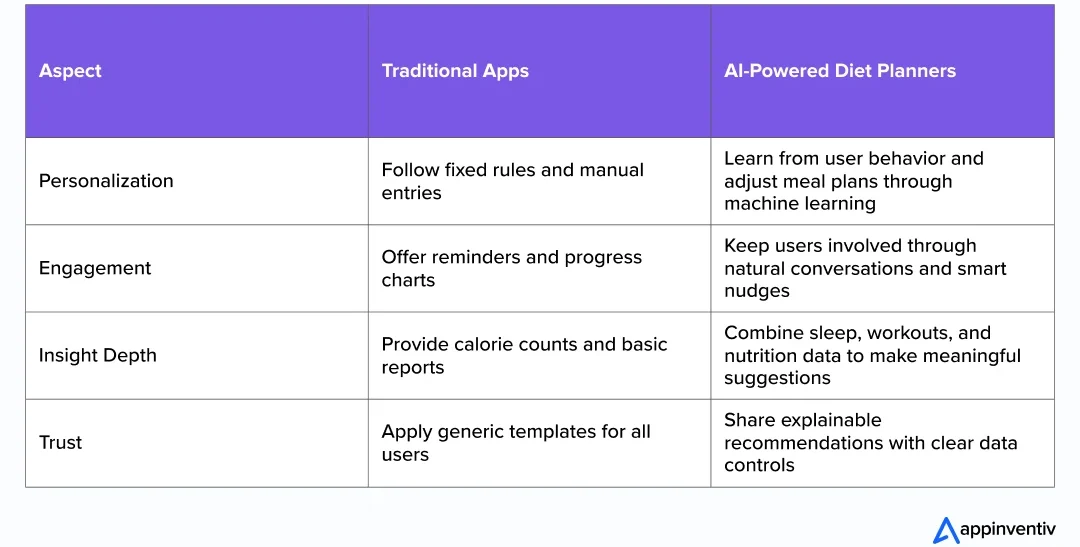
Businesses around the world are following the same shift. McKinsey reports that companies adopting generative AI are not just experimenting anymore. They are restructuring workflows and governance models to capture measurable business value. The same principle applies to AI-powered diet planner app development, where precision, compliance, and user trust decide who leads the next wave of wellness innovation.
If your vision is to create a product that grows smarter with every meal logged, explore AI-powered nutrition app development. A well-built AI foundation can power new categories such as allergy-friendly plans, Keto diet app development, and predictive calorie optimization with the features that define the future of AI-based health and diet apps.
How Much Does It Cost to Build an AI-Powered Diet Planner App
The AI diet planner app development cost can range anywhere from $40,000 to $400,000, depending on complexity and intelligence layers. The cost to build an AI diet planning app also varies based on your target users and AI maturity model. A simple app-based nutrition coach will always cost less than a feature-rich platform used by hospitals or wellness enterprises.
As your app gets smarter, it also gets more complex. Each layer of intelligence, whether it’s real-time personalization, secure data handling, or AI-driven automation — adds to both the time and the investment. The cost to develop an AI diet planner app depends on how deeply AI is embedded across recommendation, prediction, and compliance modules.
Estimated Cost Breakdown
**Assumptions: US-based rates, greenfield build, cloud-first, iOS+Android; excludes 3rd-party data/license fees.
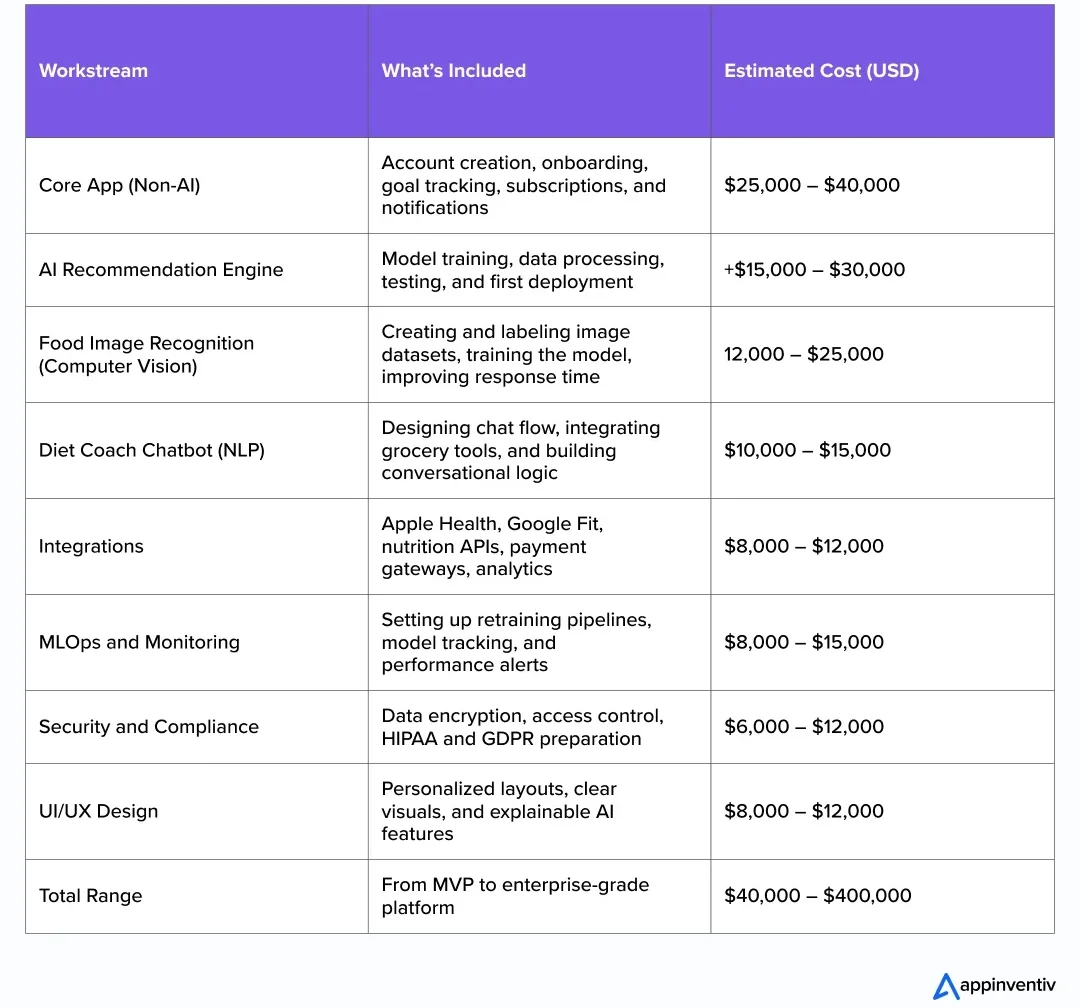
Cost by Development Stage
The smartest way to approach AI diet planner app development is to think long-term. Build lean, test fast, and scale what works.
Trying to launch everything at once only burns time and budget. The real progress happens in stages, where each phase teaches you something new about your users and your product’s potential.
MVP ($40K–$100K): This is your trial run, perfect for startups or individual nutrition coaches testing an idea. At this point, the app is simple but functional: calorie tracking, meal suggestions, and maybe an integration or two like Apple Health or Google Fit.
The focus isn’t polish; it’s proof. Get the app out there, watch how people use it, and fine-tune from real feedback. You don’t need a large team or a complex AI model yet — just a working product that shows the idea has traction.
Growth Stage ($120K–$200K): Once your base version finds its footing, the next step is all about depth. This is where AI diet planner app development really takes shape.
You start making your app smarter by adding features such as photo-based meal logging, voice or chatbot assistance, and algorithms that learn from behavior.
At this stage, your diet planning app development cost naturally rises, but so does the app’s value. It begins to feel more like a coach that learns from you than a static food tracker. These smarter layers keep users engaged and coming back every day.
Enterprise Level ($250K–$400K): When your app reaches enterprise scale, everything shifts. You’re now building for hospitals, insurers, or large wellness brands that need reliability and regulation-ready systems.
This phase includes MLOps, strong encryption, analytics dashboards, and full compliance (HIPAA, GDPR, ISO standards).
At this level, AI diet planner app development turns into building an intelligent health platform, one that’s trusted, scalable, and built for real-world impact.
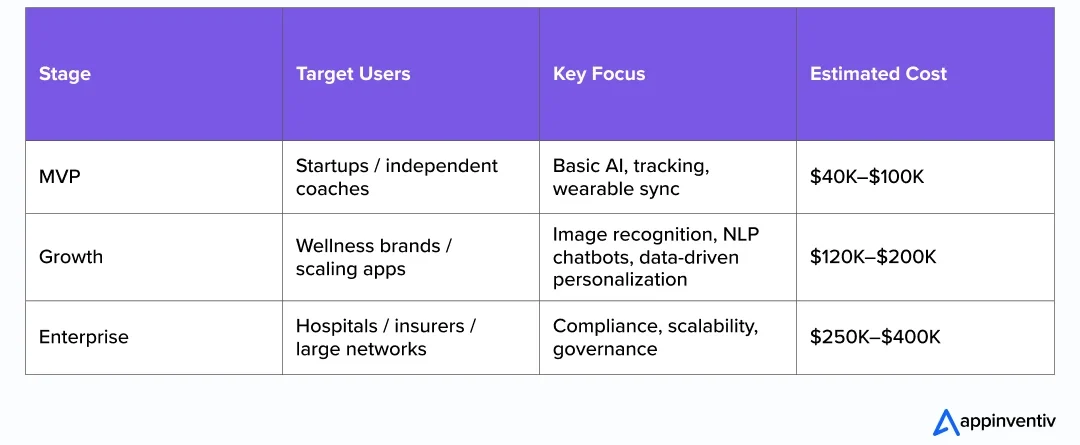
As you move from one stage to the next, your investment grows, but so does the product’s intelligence, reach, and return. The idea isn’t to spend more; it’s to grow smarter, step by step, turning a good concept into a platform people actually rely on. This approach also helps you plan your AI diet planner app development cost effectively while reducing long-term risks.
Key Factors That Influence AI Diet App Development Cost
The cost of your AI diet planner app development depends on how far you want to take your idea. It’s not just about writing code or designing screens, it’s about the intelligence your system carries, how it manages data, and how responsibly it handles user privacy.
Whether you’re building an AI diet planning app as a simple digital coach or a full-scale enterprise solution, every decision — from your AI model to your infrastructure — changes the budget. The more advanced your setup, the higher the precision, but also the higher the cost.
1. AI Model Scope and Complexity
This is the brain of your product, it is what makes your app “intelligent.” A smaller app might only use a basic recommendation engine, while more advanced ones rely on image recognition, voice interaction, or dynamic meal planning.
Modern AI-powered diet planning apps use machine learning and large language models to understand user behavior and make predictions that feel personal. If you want faster results, you can run AI on the device itself; if you need more computing power, cloud deployment works better. Both options shape how much you’ll spend, and how seamless your user experience feels.
2. Data Acquisition and Labeling
AI is only as smart as the data it learns from. Creating a dependable AI-based personalized diet planning app means gathering high-quality nutrition data, cleaning it, and keeping it updated.
Developers often rely on verified sources like USDA FoodData Central or regional equivalents, but that’s just the start. When your app includes photo-based logging, labeling becomes one of the biggest cost factors — every food image must be tagged correctly for portion, lighting, and composition so the model learns accurately.
Skipping this part usually leads to inconsistent suggestions, which can hurt user trust. Investing in AI-powered nutrition app development that values data quality early on will save major costs later.
3. Inference Infrastructure and Scalability
Once trained, your AI needs a smooth system to deliver insights in real time. That includes servers, databases, and monitoring tools that ensure everything runs efficiently.
To control costs, developers often use caching and on-device predictions to minimize cloud dependence. Still, as your user base grows, infrastructure becomes a major part of AI-powered diet planner app development. Small optimizations here, like reducing server requests or balancing workloads can save thousands of dollars each month once the app scales.
4. MLOps and Continuous Retraining
AI doesn’t freeze in time. Over months, people change diets, food trends shift, and your models can drift from reality.
That’s why successful teams invest in retraining pipelines that keep their intelligent diet app development sharp and reliable. Every few months, they collect new data, validate model accuracy, and A/B test before pushing updates live.
It’s ongoing work, but it keeps your app’s recommendations fresh, ensuring users feel the system is evolving with them, not falling behind.
5. Compliance and Security
If your app handles sensitive health data, compliance isn’t optional, it’s essential. U.S.-based products need to meet HIPAA standards, while global ones must align with GDPR.
That means encrypting user data, managing consent clearly, and letting users control what they share. Compliance takes time and planning, but it also builds credibility that is something no marketing campaign can replace.
Strong data practices not only protect users but also open doors for collaborations with healthcare networks and insurers. It’s especially crucial for AI-based health and diet apps, where personal data and health metrics live side by side.
Core Features to Have in Your AI-Powered Diet Planner App
A great AI-powered diet planner app doesn’t just count calories, it gets people. It learns their habits, moods, and routines. It doesn’t feel like another fitness app; it feels like something that quietly understands what you need, when you need it.
When an app can connect behavior with insight, it becomes more than software, it becomes a coach. But building that level of intelligence is also where complexity (and cost) start to grow. Let’s look at the key features of AI diet planner app experiences that users expect.
| AI-Enabled Features | Basic Must-Have Features |
|---|---|
| Personalized Meals – Learns tastes and goals, adjusts portions automatically. | Fast Onboarding – Quick setup that feels personal from day one. |
| Predictive Nutrition – Spots low-energy patterns and sends timely nudges. | Progress Dashboards – Visual summaries that turn effort into motivation. |
| Food Image Recognition – Snap a photo to log calories and nutrients instantly. | Community & Challenges – Adds fun and accountability with leaderboards and groups. |
| Chat-Based Coaching – Conversational guidance like “What should I eat after a run?” | Smart Reminders & Plans – Gentle check-ins and flexible subscriptions that adapt. |
| Generative Meal Planning – Auto-creates weekly plans and grocery lists that fit real schedules. | — |
| Wearable Integration – Syncs sleep, steps, and stress data for smarter insights. | — |
| Explainable Recommendations – Every tip comes with a reason, building user trust. | — |
AI Enabled Features
Traditional diet apps collect data. Smart ones make sense of it. An AI-powered diet planning app can notice when users skip breakfast, snack late, or train harder than usual. Later it can adapt without being told.
- Personalized meal recommendations: The app learns preferences over time and swaps in meals that fit current moods or goals. It adjusts portions, ingredients, or cuisines without users having to do anything.
- Predictive nutrition: By reading patterns, it knows when someone might feel low on energy or tempted to overeat and offers small, timely nudges. This is the power of predictive analytics in healthcare.
- Food image recognition: Instead of manual entry, users can just snap a photo. The AI estimates ingredients, portions, and nutrition instantly, a must-have feature in AI meal planning app development.
- Chat-based coaching: A built-in chatbot makes the experience conversational, answering quick questions like “What should I eat after a run?” or “Is this salad too heavy for dinner?” This is central to AI diet assistant app development, and you can learn more about a chatbot app development cost here.
- Generative meal planning: Using generative AI in healthcare diet planning app, it can create weekly meal plans or grocery lists that actually match daily schedules, not rigid diets.
- Integration with wearables: Syncing data from smartwatches or fitness trackers allows the app to see the full picture, from sleep to stress, which help in making smarter meal calls.
- Explainable recommendations: Each tip comes with a reason. If users give feedback (“too spicy,” “too late”), the AI listens and adapts, slowly building trust.
Basic Must Have Features
AI powers the logic, but experience drives loyalty. These are the small design touches that make users stick around. A thoughtful AI-powered diet planner app focuses not just on automation but also on emotion, helping users feel understood and guided.
- Onboarding and goal setup: The first impression counts. Keep questions short and relevant so users can get started fast with a plan that already feels personal.
- Progress dashboards: People love seeing progress. Simple visuals showcasing hydration, calorie balance, streaks, can turn effort into motivation.
- Community and challenges: A social space or leaderboard adds accountability and fun. Users feel part of something bigger than just tracking meals.
- Smart reminders and subscriptions: Notifications should feel like gentle check-ins, not pressure. And flexible plans make it easy for users to explore premium features as they grow.
Each of these experiences elevates AI diet planner app development beyond basic tracking. The more naturally the app fits into a user’s daily rhythm, the better it retains engagement, and strengthens its position among top AI-powered diet apps in the wellness ecosystem.
How AI Powered Diet PlanningApps Get Smarter Every Day
What makes AI-powered diet planning apps powerful isn’t one big breakthrough, it’s continuous learning.
Every user action feeds the system:
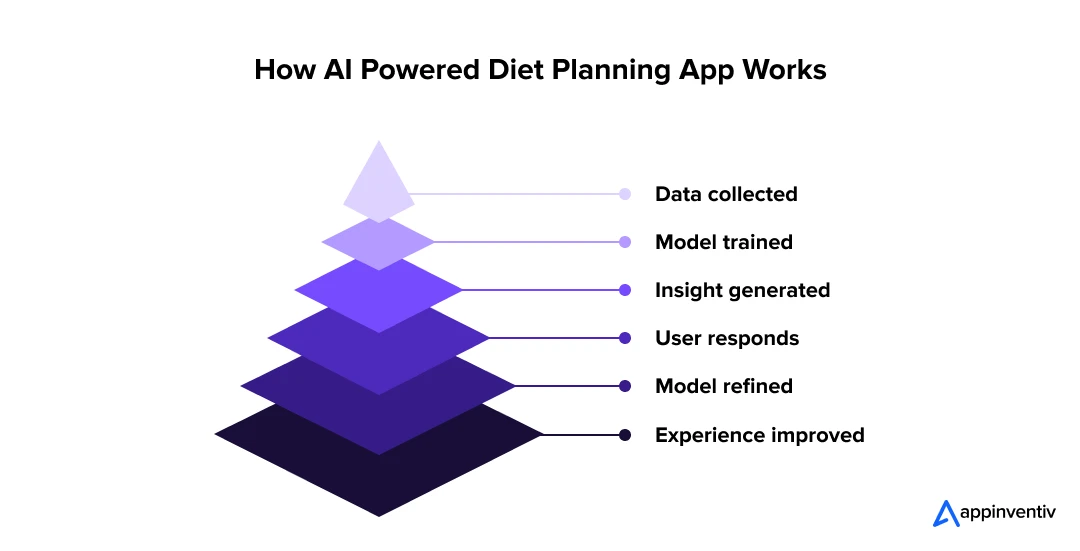
Each skipped meal, added snack, or adjusted portion becomes part of a larger understanding. Over time, your app learns what truly works for real people, in real routines.
That’s what separates a typical diet tracker from an AI diet planner. It doesn’t just guide users, it grows with them, turning everyday choices into lasting habits. When planned properly, this continuous feedback cycle keeps your AI diet planner app development relevant and adaptive across user segments.
Use Cases: How Real Brands Are Transforming Diet Planning with AI
The diet and wellness space is quietly being rewritten by AI — not through buzzwords, but through smarter design. The best AI-based health and diet apps today aren’t shouting about algorithms; they’re using them to make food tracking feel human again. They reduce friction, offer context, and help people stay consistent without constant effort.
Here’s a look at how four well-known brands are using AI to make diet planning smarter and more human, a broader trend in AI in healthcare:
1. Noom – When Logging Turns Into Coaching
Noom has moved beyond simple calorie counting. Its recent AI update lets users log food by taking a quick photo, while its new virtual assistant, Welli, steps in like a friendly guide. Welli doesn’t just give advice, it explains why a choice matters, helping users build awareness instead of guilt.
Together, they turn a once transactional experience into something more reflective and supportive, making it a prime example of AI diet assistant app development done right.
2. MyFitnessPal – From Tracking to Planning
For years, MyFitnessPal has been the go-to for people who wanted to record what they ate. Now, it’s learning to look forward. After acquiring AI startup Intent, the company began using machine learning to create personalized meal plans that evolve with each user’s habits. It no longer just tracks; it predicts.
This shift aligns closely with the goals of AI-powered diet planner app development, turning reactive tracking into proactive coaching.
3. Lumen – Turning Breath Into Data
Lumen took a bold path by combining hardware and AI. The small handheld device analyzes your breath to determine whether your body is burning fat or carbs, and then uses that information to personalize what and when you should eat. It’s a fascinating mix of real biology and machine learning, giving users daily nutrition advice rooted in real-time body data.
This approach shows how AI-based personalized diet planning apps can expand beyond screens into real-world health insights.
Source: TechCrunch
4. Fitbit – AI That Connects Diet, Sleep, and Movement
Fitbit’s newer AI tools tie everything together — sleep, exercise, and diet. Instead of leaving users to guess how much they should eat after a tiring week or a long run, Fitbit analyzes heart rate, recovery data, and daily movement to suggest realistic meal goals.
It’s no longer about hitting arbitrary calorie numbers; it’s about finding balance between how you move, rest, and refuel — the essence of modern AI-powered nutrition app development.
Together, these examples show the breadth of AI-powered diet apps, from standalone mobile tools to connected ecosystems. The takeaway is clear: intelligent design plus explainable AI creates stickiness, trust, and retention.
Let’s help you design, build, and scale with confidence.
ROI Story: Why Personalization Pays (and Why Investors Care)
In business, personalization is no longer just “nice to have” — it’s a performance lever. According to McKinsey, when companies get personalization right, they typically see revenue lifts of 10–15%, with some outperformers stretching that into a 5–25% range depending on how well they execute.
What does that mean for an AI diet planner app? It means the difference between building a “nice tool” and building a “growth engine.”
Imagine you’re a digital wellness platform with 100,000 paying users, each paying $100/year. A 10% lift in revenue means an extra $1 million that too without acquiring new users. That kind of organic uplift is gold.
Here’s how it plays out in real terms:
- Better retention, lower churn: When the app feels personally tuned, suggestions feel relevant, not generic making people to stick around. That means your acquisition cost (CAC) becomes less important over time.
- Upselling and premium tiers: An AI-powered diet planner app can more confidently recommend value-add features (advanced insights, coaching, meal planning) to users who are already seeing success.
- Operational efficiency: Because AI can automate parts of coaching, recommendations, or feedback, your human coaching load becomes more scalable — freeing resources for growth or new features.
- Stronger unit economics: Each user becomes more valuable over time. You’re not just monetizing a single subscription — you’re compounding value by deepening engagement.
Of course, this isn’t automatic. The lift you get depends on how well you design your personalization, how clean your data is, how well your AI models adapt, and how smartly you integrate insights into your UX. But for founders and investors, that 10–15% window is a credible benchmark, one that turns AI diet planner app development from a cost center into a revenue amplifier.
In short, with competition rising and user expectations growing, AI-based personalized diet planning apps are among the best-performing investments in digital wellness today. Done well, they pay for their own development — many times over.
Pitfalls (and How to Avoid Them)
Even the best AI diet planner apps can stumble if the development strategy gets ahead of real-world needs. Most failures don’t come from technology itself but from how teams plan, prioritize, or scale too early. Here are some common pitfalls to watch for — and how to sidestep them before they slow you down.
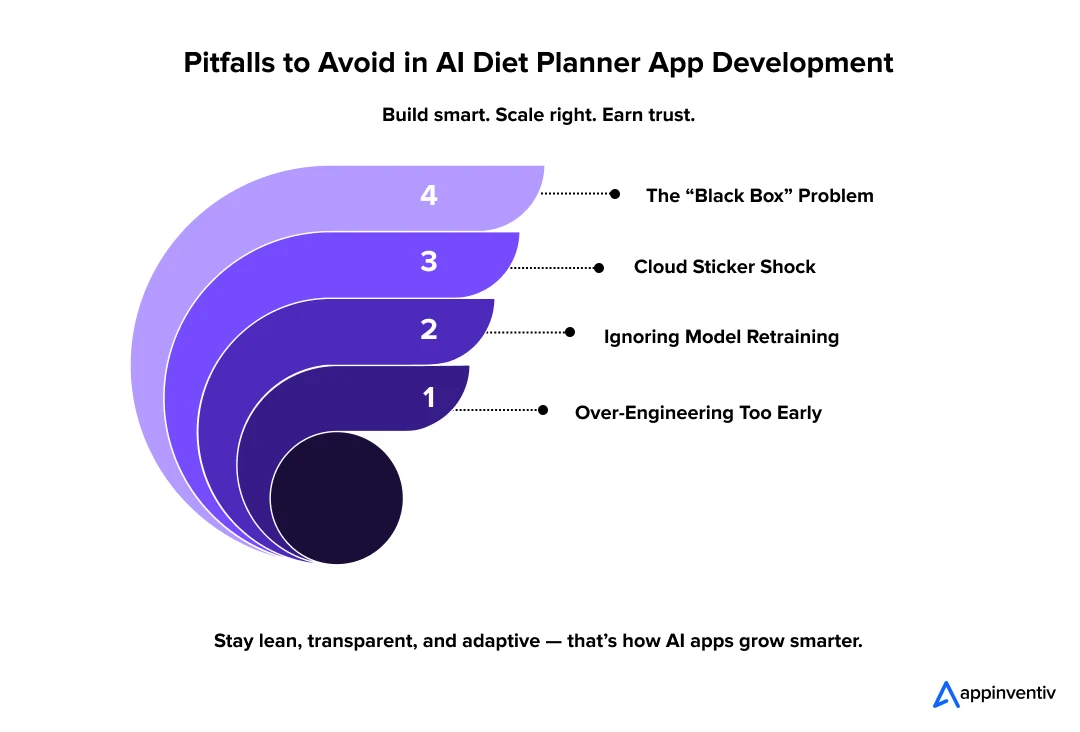
1. Over-Engineering AI Before You Validate Demand
Many teams start by building a highly complex AI stack — training large models, experimenting with personalization logic, or trying to predict every user behavior — before they even know what people actually want.
The smarter route is to start lean. Build a rules-based MVP with a touch of lightweight machine learning. Use simple data points like calorie goals, activity level, and food preferences to drive initial recommendations. Once real users start engaging and giving feedback, that data becomes the foundation for scaling your AI.
Think of it as proof, not perfection. The goal is to validate demand before investing heavily in AI diet planner app development or expanding your AI-powered nutrition app development pipeline.
2. Ignoring Model Retraining and Data Drift
AI models aren’t a “set it and forget it” system. Over time, user habits change — new foods trend, dietary goals shift, and even sensor data evolves. Without scheduled retraining, your once-smart model can start producing outdated or inaccurate suggestions.
Avoid this by setting up a retraining cadence every quarter. Review performance metrics, track drift, and test outputs against fresh data samples. A good MLOps pipeline can automate parts of this, alerting you when accuracy starts slipping. Keeping your AI updated ensures that your intelligent diet app development remains adaptive and trustworthy.
3. Cloud Sticker Shock
Running inference in the cloud sounds convenient — until your usage bills start climbing with every API call. Heavy reliance on cloud servers can eat into margins fast, especially as your user base grows.
To keep costs predictable, move repetitive tasks on-device wherever possible. Use optimized models like TensorFlow Lite or Core ML for meal recognition and caching frequently used data locally. This not only reduces cloud costs but also speeds up performance and improves privacy — a big win for both your budget and your users.
4. The “Black Box” Problem
If users don’t understand how your AI makes decisions, they eventually stop trusting it. A recommendation without context feels random — especially when it touches something as personal as food.
To avoid this, design for transparency and control. Let users see why a suggestion was made (“Your last three dinners were low in protein — here’s how to balance it”). Give them the ability to override or adjust recommendations easily.
AI Explainability builds confidence. When users feel the system is working with them, not on them, engagement naturally goes up. In short, success in AI diet planner app development isn’t about building the most advanced technology — it’s about building the right intelligence at the right time. Keep things lean, transparent, and adaptive, and your product will grow smarter alongside its users.
Compliance & Trust Checklist
Trust is the real currency in digital health. When people share personal data about their food, activity, and health patterns, they’re not just giving access — they’re giving permission. One data breach or confusing privacy clause can undo years of credibility. That’s why compliance isn’t just a legal box to tick; it’s a strategic differentiator that separates reliable products from risky ones.
As health systems across the globe tighten AI data governance frameworks in 2025, your AI-powered diet planner app needs to prove that it handles user data responsibly and transparently from day one. Deloitte notes that B2B buyers in healthcare and wellness now treat data compliance and model transparency as “non-negotiable evaluation factors” in vendor selection.
Here’s what that responsibility looks like in practice:
1. PII / PHI Handling — Protect What You Collect
When it comes to personal health data, the rule is simple: collect less, protect more.
If your AI-based health and diet apps handle personally identifiable information (PII) or protected health information (PHI), start by following the basics of data minimization and purpose limitation. Only gather what’s essential to deliver your service — and be transparent about why you’re collecting it.
Every bit of sensitive data, from calorie logs to fitness tracker inputs, should be encrypted both in transit and at rest. AES-256 is the gold standard here. Tokenize user identifiers wherever possible, and maintain clear audit trails so you can trace how data moves through your system.
If you’re building for U.S. users, HIPAA compliance isn’t optional — it’s required. For global reach, align your systems with GDPR and ISO/IEC 27001 frameworks to ensure privacy across regions.
These practices aren’t just about avoiding penalties; they’re about building credibility. In an era where users are cautious about where their data goes, strong protection is what sets trustworthy AI-based health and diet apps apart from everything else.
2. User Agency — Give People Control
AI should empower, not dictate. Build features that make users feel in control of their data and experience.
That means:
- Clear consent flows: Use plain language — no buried clauses.
- Portability: Allow users to download or transfer their nutrition data easily.
- Right to delete: Let users permanently remove their data and close accounts without friction.
Beyond compliance, this openness fosters trust. When users feel ownership of their information, they’re more likely to stay engaged long term — the foundation for sustainable AI-powered nutrition app development.
3. Explainability — Make AI Understandable
When your AI recommends a meal or suggests changing macros, users should know why. Explainability isn’t about exposing code — it’s about clarity.
Show visible cues like:
- “Recommended because your recent meals were low in protein.”
- “Alternative: a plant-based option with similar macros.”
- “Confidence: 92% match to your stated goal.”
This simple layer of transparency transforms AI from a “black box” into a collaborator. It also helps you meet upcoming EU AI Act guidelines requiring explainability for consumer-facing algorithms — a must for any custom AI diet planner app development project.
4. Governance — Build for Accountability
Responsible AI goes beyond models; it’s about processes. Create a governance framework that keeps your AI accountable throughout its lifecycle.
That includes:
- Model cards: Documentation that outlines the purpose, limitations, and data sources of each model.
- Release checklists: A review step before updates go live, ensuring accuracy and compliance haven’t slipped.
- Bias audits: Regular testing for demographic fairness, especially in nutrition data linked to gender, age, or region.
- Rollback plans: A way to revert to a previous model version quickly if something goes wrong post-deployment.
Strong governance sends a clear message — your AI diet planner app development practices aren’t just intelligent; they’re trustworthy.
Roadmap: A Phased Build to De-Risk Cost
Building an AI diet planning app isn’t about throwing every advanced feature into the first release — it’s about sequencing your growth intelligently. The smartest teams don’t scale complexity; they scale confidence. A phased development roadmap helps you validate early, learn fast, and reinvest strategically — so every dollar spent teaches you something new about your users and your product-market fit.
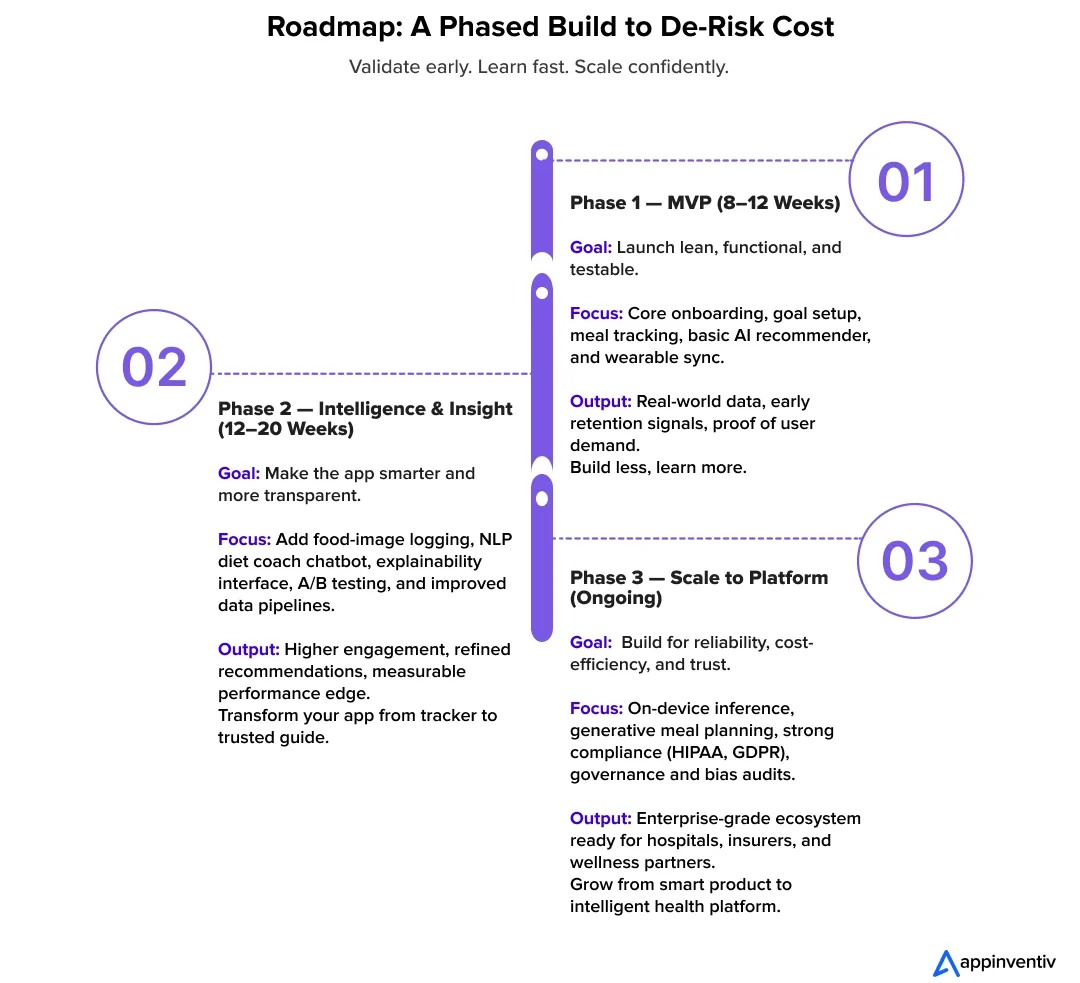
Phase 1: MVP (8–12 Weeks)
Goal: Launch something lean, functional, and testable.
At this stage, your priority is speed and usability. The minimum viable product should include essentials — a clean onboarding flow, personalized goal setup, basic meal tracking, and an early version of your AI recommender.
You can pair this with wearable integrations (like Apple Health or Google Fit) and a simple subscription or paywall setup to test monetization readiness. The AI layer doesn’t need to be advanced — even a rules-based or pre-trained recommendation system is enough to start learning from user patterns.
What you get in return: Real-world usage data, initial retention metrics, and early signals of what users actually value — without overinvesting in infrastructure or AI meal planning app development.
Phase 2: V2 – Intelligence and Insight (12–20 Weeks)
Goal: Make the app smarter, more interactive, and more transparent.
Once you’ve validated demand and early user stickiness, it’s time to introduce deeper intelligence.
This is where features like computer-vision-based food logging and a diet coach chatbot (powered by NLP) start to matter. Allow users to snap photos of their meals for instant nutritional insights — this reduces friction and increases engagement.
Add an explainability interface so users understand why a suggestion is made, and A/B testing tools to refine UI and recommendation performance in real time. This phase transforms your app from a tracker to a trusted guide.
You’ll also begin refining your data pipelines, optimizing inference latency, and preparing your ML stack for ongoing retraining. The product now has a measurable edge — both technically and experientially — and reflects best practices in AI diet assistant app development.
Phase 3: Scale From Product to Platform (Ongoing)
Goal: Build for reliability, cost-efficiency, and enterprise-grade trust.
Scaling isn’t just about adding features — it’s about building resilience. As your user base grows, so does the demand for faster inference, better security, and compliance readiness.
This phase focuses on on-device inference for frequent predictions (reducing cloud dependency and costs), generative AI capabilities for personalized meal and grocery planning, and governance frameworks for explainability, bias checks, and model rollback.
You also prepare your enterprise governance pack — documentation, compliance certifications, and reporting tools that make your app enterprise-ready for healthcare networks, insurers, and B2B wellness partners.
By this stage, your AI diet planner app development evolves into a full-fledged health ecosystem — intelligent, compliant, and ready to integrate into broader digital health infrastructure. A well-timed roadmap not only minimizes your diet planning app development cost but also keeps your innovation sustainable.
Future Trends and Market Signals to Follow (2025 and Beyond)
The wellness industry isn’t chasing AI — it’s catching up to people. Users already juggle fitness bands, glucose monitors, sleep apps, and food trackers, but what’s been missing is connection — a system that understands why someone skipped breakfast or why their energy dips every Thursday afternoon.
That’s the gap AI-powered diet planner app development is quietly closing.
We’re entering a phase where diet apps no longer just count what you eat; they interpret it. They connect daily choices with larger health patterns, turning fragmented data into clear, actionable insight. For startups and enterprises exploring AI diet planner app development, this is the moment to pay attention to where the market is heading — because the shift is already in motion.
1. Health Leaders Are All In on AI
Healthcare decision-makers aren’t debating AI anymore — they’re implementing it. According to Deloitte’s 2025 Global Health Care Outlook, more than 80% of global health leaders expect generative AI to materially impact their operations this year.
Hospitals are using AI to optimize nutrition programs, wellness providers are deploying predictive health models, and even insurers are integrating personalized diet data into preventive care plans. For anyone building AI-based health and diet apps, that’s a strong signal. The ecosystem is ready for solutions that can merge personalization, compliance, and measurable outcomes — exactly what AI-powered diet planning apps deliver.
Source: Deloitte
2. From Pilots to Production: The Execution Era
A few years ago, AI projects in health and wellness were mostly pilots — small teams running limited experiments. That phase is over.
McKinsey’s State of AI 2025 report shows that organizations are redesigning workflows and hiring governance teams to make AI sustainable at scale. This is the era of execution. AI isn’t something you add later — it’s baked into your product’s foundation.
For app builders, that means investing in retraining pipelines, model monitoring, and responsible deployment early on. The companies that do this are already moving faster because they don’t need to “catch up” when compliance or reliability become table stakes. Those investing early in AI-powered nutrition app development and custom AI diet planner app development will lead this wave.
Source: McKinsey & Company
3. The Personalization Gap Keeps Getting Wider
Users don’t want “diet apps.” They want personal systems that adapt — quietly — around their preferences and rhythms.
McKinsey’s latest personalization study found that 71% of customers expect tailored interactions, while 76% feel frustrated when brands fail to deliver them. That’s not just a marketing stat — it’s a design challenge.
The next generation of AI-based personalized diet planning apps will merge behavioral psychology with data science: recommending meals based on emotional triggers, work schedules, and sleep quality — not just calorie counts. Those who can personalize responsibly — by showing users why a suggestion appears — will win both loyalty and trust.
Source: McKinsey & Company
4. HealthTech’s Growth Curve Is Accelerating
Digital health is now one of the fastest-growing investment categories. TIME and Statista’s “Top HealthTech Companies of 2025” spotlight a clear pattern — the strongest players are those combining AI with measurable impact. From personalized nutrition to chronic disease prevention, these companies are reshaping wellness into a data-driven ecosystem.
For developers, this means more opportunities for strategic partnerships and integrations. Whether you’re tapping into open nutrition APIs or connecting with wearable ecosystems, aligning your app with established data standards boosts both credibility and scale. This evolution will also open new pathways for Keto diet app development and other specialized niches within AI-powered diet planner app development.
Source: TIME + Statista
5. What’s Next: The Next 3 Years of AI in Nutrition
The next wave of innovation will focus less on automation and more on collaboration — between humans and AI.
A few clear shifts are emerging:
- Hybrid nutrition coaching: AI handles repetitive tracking and analysis, while experts focus on behavioral support.
- On-device intelligence: Predictions and suggestions run locally to protect privacy and cut costs.
- Preventive health ecosystems: Apps will connect with wearables, blood test APIs, and glucose sensors to offer real-time, holistic insights.
- Transparent AI regulation: The EU AI Act and other global frameworks will force apps to show how their models make decisions.
The direction is clear: people want technology that understands them without owning them. AI diet planner app development isn’t about replacing human advice — it’s about making personalization effortless, safe, and accessible.
Your users deserve more than another calorie tracker. Let’s build something that learns with them.
Why Partner with Appinventiv
At Appinventiv, we don’t just build apps — we build intelligent ecosystems. Our experience in AI diet planner app development combines deep expertise in AI services & solutions with proven success across global health tech products. From personalized nutrition platforms to hospital-grade wellness systems, we focus on creating products that are as compliant as they are innovative.
Our approach goes beyond coding. Every project we deliver — from consumer fitness to enterprise-grade healthcare — embeds transparency, observability, and governance into the core. Our YouCOMM health app is a strong example: an AI-enabled solution that helps hospital patients communicate instantly with medical staff, improving response time by 60%. That same blend of empathy and engineering drives every health product we build.
If you’re exploring healthcare software development services, partner with a team that knows how to balance innovation with trust. Deloitte’s 2025 outlook shows over 80% of health leaders plan to integrate genAI into operations — now’s the time to lead with confidence.
Let’s innovate your product with AI — responsibly, compliantly, and at scale.
FAQs
Q. How much does it cost to develop an AI-powered diet planner app?
A. The cost to develop an AI diet planner app usually starts around $40,000 for an MVP and can go up to $400,000 for an enterprise-ready product. It really depends on what you’re building.
A simple version with meal tracking and recommendations is cheaper, while full-fledged AI diet planner app development with chatbots, image recognition, and data analytics takes more time and investment.
If you plan to include features like a Vegan/vegetarian diet planner or an Allergy-friendly diet app, expect higher costs due to the need for specialized datasets, testing, and compliance.
Q. What key features should an AI diet planner app include?
A. A great AI-powered diet planner app feels less like a tracker and more like a personal coach. Some must-have features include:
- Smart meal recommendations that adapt to your habits
- Food image recognition for quick logging
- Predictive nutrition and progress tracking
- Conversational chatbots for guidance
- Seamless integration with wearables
- Clear, explainable AI suggestions
To make your app inclusive, you can also add Vegan/vegetarian diet planner filters or build an Allergy-friendly diet app module that tailors meals to specific health needs.
Q. How can AI diet planner apps help users achieve their health goals?
A. AI brings personalization to everyday nutrition. An AI-based personalized diet planning app studies how users eat, move, and rest — and turns that data into smarter advice.
Someone using a Vegan/vegetarian diet planner might get help balancing nutrients like iron or B12, while an Allergy-friendly diet app can flag unsafe foods in real time.
Over time, the app becomes a learning partner — helping users stay consistent, eat mindfully, and build sustainable habits.
Q. What is the development process for an AI diet planner app?
A. The AI diet planner app development process usually happens in three stages:
- Start with an MVP — build a simple version for testing, with tracking, goal setup, and basic recommendations.
- Add intelligence — bring in NLP chatbots, computer vision for food logging, and predictive analytics.
- Scale and secure — integrate compliance, retraining pipelines, and data governance.
This approach makes it easier to test new features like Vegan/vegetarian diet planner modes or Allergy-friendly diet app functions without overspending early.
If you’re unsure how to develop an AI diet planning app, this staged model keeps both costs and risks in check.
Q. How to reduce AI diet app development costs?
A. Start lean. Build your first version with only the core features, test it with real users, and upgrade from there.
A simple rules-based AI can get you early traction without heavy upfront investment. Using pre-trained models, open-source tools, and cloud cost optimization can also help.
If you’re planning to hire diet app developers, look for those familiar with AI-powered nutrition app development and healthcare compliance — they’ll save you time and rework later.
Q. How can Appinventiv help build an AI-powered diet planner app?
A. At Appinventiv, we’ve helped businesses transform wellness ideas into full-scale digital products. Our team specializes in AI diet planner app development, combining data science, compliance, and design into seamless user experiences.
Whether you’re building a Vegan/vegetarian diet planner, an Allergy-friendly diet app, or a global nutrition platform, we offer the best AI diet planner app development solutions for your goals.
With our proven AI diet planner app development process, transparent communication, and strong post-launch support, we help you go from concept to market — fast, responsibly, and at scale.
If you’re ready to bring your idea to life, you can hire diet app developers from Appinventiv who’ve already built successful health and wellness products worldwide.


- In just 2 mins you will get a response
- Your idea is 100% protected by our Non Disclosure Agreement.
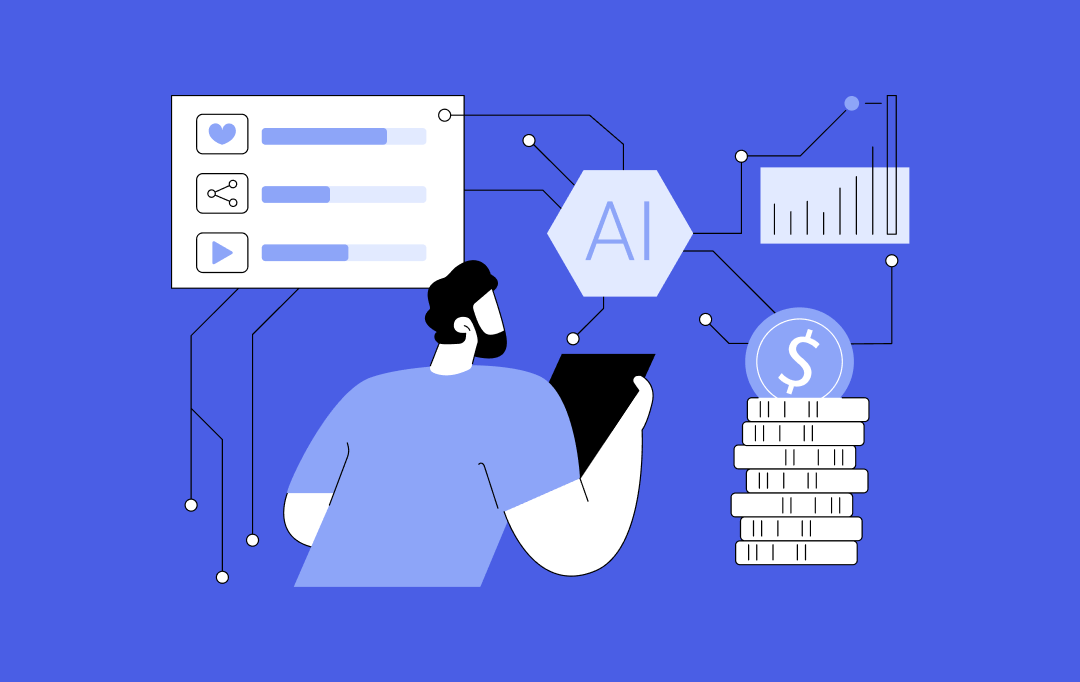
How AI Tokenization is Enabling Secure and Transparent Asset Ownership in 2026
By 2026, AI tokenization has moved beyond early-stage experiments and pilot projects. Tokenizing real-world assets has become a serious commercial strategy for financial institutions, supply chain operators and technology-driven enterprises. A 2025 report by the World Economic Forum in collaboration with Accenture highlights tokenization as a key mechanism for value exchange in modern financial markets.…

13 Ways Generative AI is Transforming the Hospitality Industry
Key takeaways: The most mature applications of Generative AI for hospitality are in guest service, revenue management, marketing, and operations automation. Real value comes from integrating generative AI into hospitality operations and existing PMS, CRS, CRM, and POS systems, rather than using stand-alone tools. Successful programs treat Generative AI in hospitality as a product, incorporating…
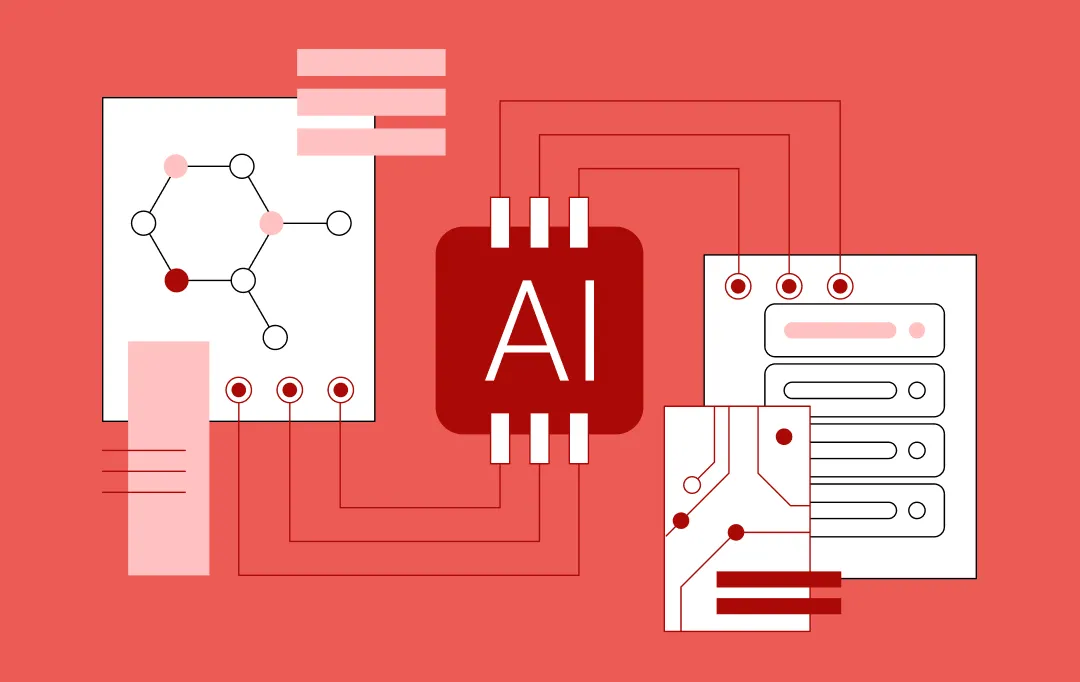
Scaling AI Initiatives: Why MLOps Matters More Than DevOps
Key takeaways: DevOps runs systems. MLOps keeps decisions accurate. MLOps vs DevOps is a leadership choice, not a technical one. Scaling AI without MLOps only scales risk. MLOps turns AI into infrastructure, not experiments. Operational maturity beats model sophistication. Real advantage comes from mastering DevOps and machine learning together. Most leadership teams don’t fail at…











